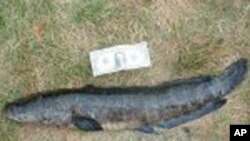The snakehead, a variety of fish native to Asia and Africa that has recently gained a foothold in some American waterways, has not done the damage that biologists once feared.
No one knows for sure how snakeheads were first introduced into the United States, but they gained considerable attention in 2002 when they were discovered in a Maryland pond. Once they took hold, the fish spread rapidly and has been found in an increasing number of U.S. waterways.
Early on, scientists worried that in a new location, without its natural enemies, snakeheads would spread out of control and crowd out native fish. The fish with a narrow, snake-like head has primitive lungs so that it can breathe out of the water and a voracious appetite. They have protruding lower jaws that usually contain dog-like teeth. They can become fairly large; the largest snakehead on record was four feet in length.
Not long after being spotted in the United States, rumors spread that the fish had the unique ability to travel far distances over land and that they were capable of attacking pets and small children. People began calling them “frankenfish,” connecting them in the mind of the public with novelist Mary Shelley’s infamous monster, “Frankenstein.”
The rumors turned out to be false, but the scary reputation stuck. Hollywood actually released two movies based on the fish, one called Snakehead Terror [2004].
Amy Benson, a biologist with the U.S. Geological Survey in Gainesville, Florida, is an expert on snakeheads.
Has the snakehead done any damage to U.S. waterways?
No one really knew what was possible and impacts are really, really hard to determine. So, I think what we can say is, we have not found a lot of impact to date.
Where are these fish found in the U.S.?
There are several established populations and the largest one is in the Potomac River. Right now the population is a little north of Washington in the Potomac River, but it is being stopped by a “dam” there, a falls. The other populations I’d like to mention are in Arkansas in a small creek there. It is a tributary eventually that would go into the Mississippi, but so far, none have been collected from the Mississippi drainage. Other populations include the Philadelphia area, and I believe they are getting out into the Delaware River. There is also a wild population growing in upstate New York.
Now that snakeheads have arrived and apparently have done no harm, should we just relax and adjust to their presence?
I think we are going to have to. I don’t think we can eradicate them. They are way too widespread now, widespread in the Potomac River, to do anything about them. I wouldn’t say that we are not worried, but the best we can do right now is just to try to educate the public as to not to inadvertently spread these species, because we can’t do much about them currently. We just want to stop the further spread of them.







